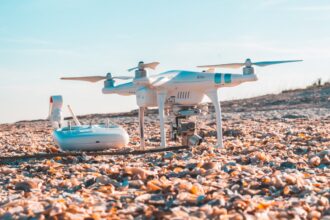Drone warfare has emerged as a significant component of modern military strategy, revolutionizing the way conflicts are conducted. Unmanned aerial vehicles (UAVs), commonly known as drones, have been utilized for surveillance, reconnaissance, and targeted strikes, allowing military forces to engage in operations with reduced risk to personnel. The proliferation of drone technology has not only transformed traditional combat scenarios but has also raised concerns about the implications of their use in warfare, particularly regarding critical infrastructure.
As nations increasingly rely on drones for both offensive and defensive operations, understanding the dynamics of drone warfare becomes essential for assessing its impact on society and security. The advent of drone warfare has introduced a new paradigm in military engagement, characterized by precision and efficiency. However, this technological advancement comes with its own set of challenges and vulnerabilities.
Critical infrastructure, which encompasses essential systems such as power grids, transportation networks, and communication facilities, is increasingly at risk from drone attacks. The ability of drones to bypass conventional defenses and strike at the heart of a nation’s operational capabilities poses a significant threat. As such, it is imperative to explore the vulnerabilities of critical infrastructure to drone warfare and the broader implications for national security.
Key Takeaways
- Drone warfare has become an increasingly prevalent method of attack in modern conflicts.
- Critical infrastructure includes systems and assets vital for the functioning of a society and economy.
- Critical infrastructure is vulnerable to drone attacks due to its interconnected and often open nature.
- Case studies of drone attacks on critical infrastructure highlight the potential for widespread disruption and damage.
- The economic, environmental, legal, and diplomatic impacts of drone warfare on critical infrastructure are significant and far-reaching.
Overview of Critical Infrastructure
Critical infrastructure refers to the assets and systems that are vital for the functioning of a society and economy. These include sectors such as energy, water supply, transportation, healthcare, and information technology. The interdependence of these systems means that a disruption in one area can have cascading effects on others, leading to widespread consequences.
For instance, an attack on a power grid can cripple communication networks and halt transportation systems, demonstrating the fragility of interconnected infrastructures. In recent years, the importance of safeguarding critical infrastructure has gained prominence in national security discussions. Governments around the world have recognized that threats to these systems can come from various sources, including natural disasters, cyberattacks, and increasingly, drone warfare.
The reliance on technology in managing and operating critical infrastructure makes it susceptible to innovative forms of attack. As drone technology continues to evolve, understanding the vulnerabilities inherent in these systems becomes crucial for developing effective defense strategies.
Vulnerabilities of Critical Infrastructure to Drone Warfare

The vulnerabilities of critical infrastructure to drone warfare are multifaceted and complex. One primary concern is the physical accessibility that drones provide to potential attackers.
This capability allows adversaries to target critical assets that may have previously been considered secure. The ability to conduct surveillance and gather intelligence using drones further enhances the threat landscape, as attackers can identify weaknesses in security measures before launching an assault. Moreover, the technological sophistication of drones has increased significantly, enabling them to carry payloads that can cause substantial damage.
Armed drones equipped with explosives or other destructive devices can strike with precision, targeting specific components of critical infrastructure. This precision not only amplifies the potential for destruction but also complicates response efforts. Traditional defense mechanisms may be ill-equipped to counteract the unique challenges posed by drone attacks, necessitating a reevaluation of existing security protocols.
Case Studies of Drone Attacks on Critical Infrastructure
| Location | Date | Type of Infrastructure | Damage |
|---|---|---|---|
| Saudi Arabia | September 2019 | Oil Refinery | Significant damage, production disruption |
| Ukraine | June 2017 | Power Grid | Temporary power outage |
| Syria | March 2018 | Water Treatment Plant | Contamination, water supply disruption |
Several notable case studies illustrate the vulnerabilities of critical infrastructure to drone attacks. One prominent example occurred in 2019 when drones targeted Saudi Arabia’s Abqaiq oil processing facility and Khurais oil field. This coordinated attack resulted in significant disruptions to global oil supply and highlighted the potential for drones to inflict damage on vital energy infrastructure.
The incident underscored how a relatively small number of drones could achieve strategic objectives by crippling a nation’s economic lifeline. Another case study involves the use of drones in conflict zones where critical infrastructure is often collateral damage. In Syria, for instance, various factions have employed drones to target water treatment facilities and power plants, exacerbating humanitarian crises.
These attacks not only disrupt essential services but also contribute to long-term instability in affected regions. Such examples demonstrate that drone warfare is not limited to military targets; it extends into civilian domains where the consequences can be dire.
Economic Impact of Drone Warfare on Critical Infrastructure
The economic ramifications of drone warfare on critical infrastructure are profound and far-reaching. Disruptions caused by drone attacks can lead to immediate financial losses for businesses and governments alike. For instance, an attack on an oil facility can result in skyrocketing fuel prices and supply chain disruptions that ripple through various sectors of the economy.
The costs associated with repairing damaged infrastructure can be astronomical, diverting resources away from other critical needs. Furthermore, the fear of potential drone attacks can lead to increased security expenditures as organizations invest in protective measures. This shift in focus can strain budgets and divert funds from essential services such as education or healthcare.
The long-term economic impact may also manifest in reduced foreign investment as companies become wary of operating in regions perceived as vulnerable to drone warfare. Thus, the economic consequences extend beyond immediate damages, affecting overall stability and growth prospects.
Environmental Impact of Drone Warfare on Critical Infrastructure

The environmental impact of drone warfare on critical infrastructure is an often-overlooked aspect of this modern conflict paradigm. When drones strike energy facilities or industrial sites, they can release hazardous materials into the environment, leading to pollution and ecological degradation. For example, an attack on a chemical plant could result in toxic spills that contaminate local water supplies and harm wildlife.
Additionally, the destruction of critical infrastructure can disrupt environmental management systems that are essential for maintaining ecological balance. Water treatment facilities, for instance, play a crucial role in ensuring clean water access; their incapacitation due to drone strikes can lead to public health crises and exacerbate existing environmental issues. As such, the environmental consequences of drone warfare extend beyond immediate destruction, posing long-term challenges for sustainability and ecological health.
Legal and Ethical Considerations of Drone Warfare on Critical Infrastructure
The use of drones in warfare raises significant legal and ethical questions regarding their deployment against critical infrastructure. International humanitarian law stipulates that parties engaged in armed conflict must distinguish between military targets and civilian objects; however, the blurred lines created by drone warfare complicate this distinction. Attacks on critical infrastructure often have dual-use capabilities—serving both civilian and military purposes—which raises concerns about compliance with legal norms.
Ethically, the implications of targeting critical infrastructure are profound. The potential for civilian casualties and collateral damage raises moral dilemmas about the justification for such actions. The principle of proportionality must be carefully considered when evaluating drone strikes against infrastructure that supports civilian life.
As nations grapple with these legal and ethical challenges, there is a pressing need for international dialogue to establish clear guidelines governing the use of drones in warfare.
Strategies for Protecting Critical Infrastructure from Drone Warfare
To mitigate the risks posed by drone warfare to critical infrastructure, comprehensive protection strategies must be developed and implemented. One approach involves enhancing surveillance capabilities around key assets to detect unauthorized drone activity early on. This could include deploying advanced radar systems or utilizing artificial intelligence algorithms capable of identifying potential threats in real-time.
Additionally, physical barriers such as netting or anti-drone technologies can be employed to intercept drones before they reach their targets. Governments and organizations must also invest in training personnel to respond effectively to drone threats, ensuring that security teams are equipped with the knowledge and tools necessary to counteract potential attacks. Collaboration between public and private sectors is essential for creating a robust defense framework that addresses vulnerabilities across various domains.
International Relations and Diplomatic Implications of Drone Warfare on Critical Infrastructure
The rise of drone warfare has significant implications for international relations and diplomacy.
Countries may feel compelled to enhance their own military capabilities in response to perceived threats from adversaries employing drones against critical infrastructure.
Moreover, incidents involving drone attacks can strain diplomatic relations between nations. For instance, if one country conducts a drone strike that inadvertently affects another nation’s critical infrastructure, it could lead to tensions or even conflict escalation. Establishing international norms governing the use of drones in warfare is crucial for mitigating these risks and fostering cooperation among nations.
Future Trends and Developments in Drone Warfare and Critical Infrastructure
As technology continues to advance, future trends in drone warfare will likely shape the landscape of critical infrastructure protection. Innovations such as swarm technology—where multiple drones operate collaboratively—could pose new challenges for defense systems designed to counter individual threats. Additionally, advancements in artificial intelligence may enable drones to conduct autonomous operations with minimal human intervention.
The integration of counter-drone technologies will also play a pivotal role in shaping future developments. As adversaries become more adept at utilizing drones for attacks on critical infrastructure, defensive measures will need to evolve accordingly. This dynamic interplay between offensive capabilities and defensive strategies will define the future trajectory of drone warfare and its impact on critical infrastructure.
The Importance of Safeguarding Critical Infrastructure from Drone Warfare
In conclusion, safeguarding critical infrastructure from the threats posed by drone warfare is paramount for ensuring national security and societal stability. The vulnerabilities inherent in these systems necessitate proactive measures that encompass technological advancements, legal frameworks, and international cooperation. As nations navigate the complexities of modern warfare, understanding the implications of drone technology becomes increasingly vital.
The economic, environmental, legal, and ethical dimensions associated with drone warfare highlight the multifaceted challenges that must be addressed comprehensively. By prioritizing the protection of critical infrastructure against potential drone attacks, governments can enhance resilience against emerging threats while fostering a secure environment for their citizens. Ultimately, a collaborative approach that involves stakeholders from various sectors will be essential for developing effective strategies to mitigate risks associated with drone warfare in an increasingly interconnected world.
Drone warfare has increasingly become a significant concern for the security of critical infrastructure worldwide. As drones become more accessible and advanced, they pose potential threats to essential facilities such as power plants, communication networks, and transportation systems. The ability of drones to bypass traditional security measures and deliver payloads with precision makes them a formidable tool in the hands of adversaries. For a deeper understanding of the implications of drone warfare on critical infrastructure, you can explore a related article on this topic by visiting In The War Room. This resource provides insights into the evolving nature of drone technology and its impact on national and global security frameworks.
FAQs
What is drone warfare?
Drone warfare refers to the use of unmanned aerial vehicles (UAVs) or drones in military operations. These drones can be used for surveillance, reconnaissance, and targeted strikes.
What is critical infrastructure?
Critical infrastructure refers to the physical and cyber systems and assets that are essential for the functioning of a society and economy. This includes systems such as power plants, water treatment facilities, transportation networks, and communication systems.
How are drones used in warfare against critical infrastructure?
Drones can be used in warfare against critical infrastructure in several ways, including surveillance to gather intelligence on potential targets, reconnaissance to identify vulnerabilities, and targeted strikes to disrupt or destroy critical infrastructure assets.
What are the potential risks of drone warfare against critical infrastructure?
The potential risks of drone warfare against critical infrastructure include the disruption of essential services, economic damage, and potential loss of life. Additionally, the use of drones in warfare raises legal and ethical concerns.
How can critical infrastructure be protected from drone warfare?
Critical infrastructure can be protected from drone warfare through measures such as the development of counter-drone technology, the implementation of physical security measures, and the establishment of regulations and policies to mitigate the risks posed by drones.




